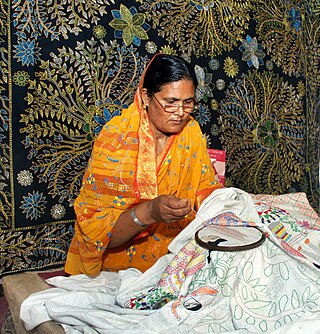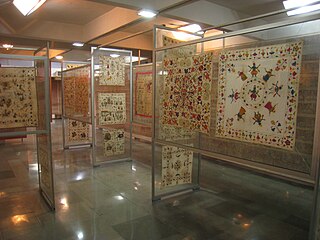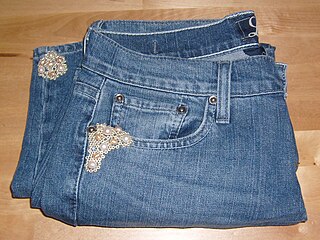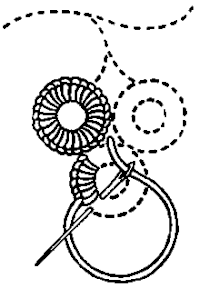
Embroidery is the art of decorating fabric or other materials using a needle to stitch thread or yarn. Embroidery may also incorporate other materials such as pearls, beads, quills, and sequins. In modern days, embroidery is usually seen on hats, clothing, blankets, and handbags. Embroidery is available in a wide variety of thread or yarn colour. It is often used to personalize gifts or clothing items.

Tunisian crochet or Afghan crochet is a type of crochet that uses an elongated hook, often with a stopper on the handle end, called an Afghan hook. It is sometimes considered to be a mixture of crocheting and knitting. As such, some techniques used in knitting are also applicable in Tunisian crochet. One example is the intarsia method.

Hardanger embroidery or "Hardangersøm" is a form of embroidery traditionally worked with white thread on white even-weave linen or cloth, using counted thread and drawn thread work techniques. It is sometimes called whitework embroidery.

Crewel embroidery, or crewelwork, is a type of surface embroidery using wool. A wide variety of different embroidery stitches are used to follow a design outline applied to the fabric. The technique is at least a thousand years old.

A lockstitch is the most common mechanical stitch made by a sewing machine. The term "single needle stitching", often found on dress shirt labels, refers to lockstitch.

Chain stitch is a sewing and embroidery technique in which a series of looped stitches form a chain-like pattern. Chain stitch is an ancient craft – examples of surviving Chinese chain stitch embroidery worked in silk thread have been dated to the Warring States period. Handmade chain stitch embroidery does not require that the needle pass through more than one layer of fabric. For this reason the stitch is an effective surface embellishment near seams on finished fabric. Because chain stitches can form flowing, curved lines, they are used in many surface embroidery styles that mimic "drawing" in thread.

Kantha, also spelled kanta or qanta, is a type of embroidery craft in Bangladesh and eastern regions of India, particularly in the Indian states of West Bengal, Tripura and Odisha. In Odisha, old saris are stacked on each other and hand-stitched to make a thin piece of cushion. This is normally used above a bed cushion or instead of a cushion. "Kantha saris" are traditionally worn by women in Bengal region. In these days, embroidery is stitched, popularly known as 'kantha stitched", on sari, kurta and churidar and many other garments and gaining popularity due to their aesthetic value and handmade characteristics.

Armenian needlelace is a pure form of needle lace made using only a needle, thread and pair of scissors.

Backstitch or back stitch and its variants stem stitch, outline stitch and split stitch are a class of embroidery and sewing stitches in which individual stitches are made backward to the general direction of sewing. In embroidery, these stitches form lines and are most often used to outline shapes and to add fine detail to an embroidered picture. It is also used to embroider lettering. In hand sewing, it is a utility stitch which strongly and permanently attaches two pieces of fabric. The small stitches done back-and-forth makes the back stitch the strongest stitch among the basic stitches. Hence it can be used to sew strong seams by hand, without a sewing machine.

Chikankari is a traditional embroidery style from Lucknow, India. Translated, the word means embroidery, and it is one of Lucknow's best known textile decoration styles. The main market in Lucknow for Chikankari based products is Chowk. Production is mainly based in Lucknow and in the adjoining districts.

Embroidery in India includes dozens of embroidery styles that vary by region and clothing styles. Designs in Indian embroidery are formed on the basis of the texture and the design of the fabric and the stitch. The dot and the alternate dot, the circle, the square, the triangle, and permutations and combinations of these constitute the design.

Knitted fabric is a textile that results from knitting, the process of inter-looping of yarns or inter-meshing of loops. Its properties are distinct from woven fabric in that it is more flexible and can be more readily constructed into smaller pieces, making it ideal for socks and hats.

Buttonhole stitch and the related blanket stitch are hand-sewing stitches used in tailoring, embroidery, and needle lace-making.

Featherstitch or feather stitch and Cretan stitch or faggoting stitch are embroidery techniques made of open, looped stitches worked alternately to the right and left of a central rib. Fly stitch is categorized with the featherstitches.

The straight or running stitch is the basic stitch in hand-sewing and embroidery, on which all other forms of sewing are based. The stitch is worked by passing the needle in and out of the fabric at a regular distance. All other stitches are created by varying the straight stitch in length, spacing, and direction.

Bead embroidery is a type of beadwork that uses a needle and thread to stitch beads to a surface of fabric, suede, or leather.

In the textile arts, a stitch is a single turn or loop of thread, or yarn. Stitches are the fundamental elements of sewing, knitting, embroidery, crochet, and needle lace-making, whether by hand or machine. A variety of stitches, each with one or more names, are used for specific purposes.

Embroidery was an important art in the Islamic world from the beginning of Islam until the Industrial Revolution disrupted traditional ways of life.

The Kutch Embroidery is a handicraft and textile signature art tradition of the tribal community of Kutch District in Gujarat, India. This embroidery with its rich designs has made a notable contribution to the Indian embroidery traditions. The embroidery, practiced normally by women is generally done on fabrics of cotton, in the form of a net using cotton or silk threads. In certain patterns, it is also crafted over silk and satin. The types of stitches adopted are “square chain, double buttonhole, pattern darning, running stitch, satin and straight stitches”. The signature effect of the colorful embroidery sparkles when small mirrors called abhla are sewn over the geometrically shaped designs. Depending on the tribal sub groups of Rabari, Garasia Jat, and Mutava involved with this craft work many hand embroidered ethnic styles have evolved. These six styles: Suf, khaarek, Paako, Rabari, Garasia Jat, and Mutava.





















